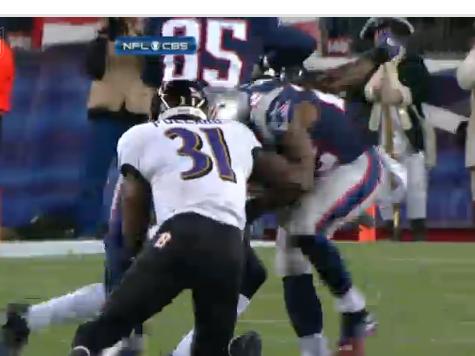When Baltimore Ravens safety Bernard Pollard tackled New England Patriots running back Stevan Ridley early in the 4th quarter of Sunday’s AFC Championship game, the Patriots were down 21-13, still only one possession out of contention. But the brutal head-to-head collision between the two knocked Ridley out. As he fell to the ground, arms flailing in the classic “fencing response” of someone experiencing a brain injury, he fumbled the ball, and the Ravens recovered it in Patriots’ territory.
“It was the turning point of the game,” Ravens head coach John Harbaugh said after the game.
To many fans watching the collision around the country, it also appeared to be a turning point in Stevan Ridley’s life. To the layman, it is hard to imagine that the hit did not cause permanent damage to Ridley’s brain, or at the very least move him closer to the trigger point for Chronic Traumatic Encephalopathy (CTE).
The Ravens easily won the game, 28-13, and are headed to the Super Bowl, where they face the San Francisco 49ers a week from Sunday in what’s been called “The HarBowl,” since it is the first Super Bowl where the opposing teams are coached by brothers (John Harbaugh of the Ravens, Jim Harbaugh of the 49ers).
What caught the attention of many football fans who have followed the NFL’s brain injury problem over the past several years were the comments of Ravens coach John Harbaugh made about the Pollard head to head hit on Ridley in his post-game press conference. It was, he said, “football at its finest.”
The juxtaposition of that comment with the physical evidence of a man clearly suffering a brain injury on a play watched on live television by millions of NFL fans was more than a bit jarring. But a closer look at the hit itself suggests it was legal.
Pollard has a reputation as a “dirty player” who specializes in taking out Patriot players. When he was playing for the Kansas City Chiefs in 2008, he took Tom Brady out of the game and season with a hit to the knee. Later, as a member of the Houston Texans in 2010 he took Wes Welker out for the season. And last year as a Raven he hurt Rob Gronkowski’s ankle in the AFC title game.
Despite Pollard’s reputation, a look at the replay of the hit shows that the officials were correct not to penalize him for an illegal head to head hit. Though head-to-head hits are illegal when a player “launch[es] himself off the ground and use[s] his helmet to strike a player in a defenseless posture in the head or neck,” rules allow head-to-head hits when the offensive player is carrying the ball and is not “defenseless.”
In this particular play, the replay shows that it wasn’t Pollard who targeted Ridley’s head. Instead, it was Ridley, the ball carrier, who lowered his head just a second before the collision to use as a battering ram against Pollard, the defender. In the video replay, Ridley is running with his head upright barely a second before the hit. Pollard’s head is positioned significantly below his. Right before impact, Ridley lowers his head to initiate the head-to-head hit with Pollard.
Many defenders have complained they are using proper technique and often only hit the running back or wide receiver head-to-head because the running back or wide receiver lowers his head in an attempt to overpower the defender. Ridley, for instance, was known for lowering his head like a battering ram when he played college ball at LSU. The technique was successful over smaller college defenders. But as he learned Sunday, defenders in the NFL are not so easily overpowered.
Some star running backs are used to always being the strongest person when they play in high school or college. They succeed at that level by lowering their head to knock out the defender, and they take that habit to the next level. Sometimes it works. Jacquizz Rodgers of the Atlanta Falcons, for instance, lowered his head and ran over Seattle Seahawks safety Earl Thomas two weeks ago, and the video of that encounter was frequently replayed and celebarted on ESPN’s SportsCenter.
That was what Ridley was trying to do against Pollard, but it was Ridley, not Pollard, who was the guy knocked unconscious and today may be dealing with a potential long term brain injury.
The New England Patriots have not released much information about Ridley’s status. Head coach Bill Bellicheck didn’t mention Ridley’s injury during his season ending press conference on Monday, and, surprisingly, none of the reporters in attendance asked him about Ridley.
Without rule changes that prohibit running backs and wide receivers from lowering their heads to initiate head to head contact, NFL fans are likely to see–live and in High Definition color–more collisions that leave one or both players involved with obvious acute or chronic brain trauma.
Perhaps Baltimore Ravens coach John Harbaugh is correct. That may be “football at its finest.” However, it’s increasingly clear that “football at its finest” in the NFL as it is currently played is a very high-risk game that is certain to leave many who play it with permanent brain injuries.
Those of us who believe in individual liberty support the right of NFL football players to freely choose to expose themselves to this level of risk, and for fans to watch a game knowing the players are at risk. However, it’s also true that the players deserve to know the full degree of risk involved in the game, and make their own personal choices accordingly.

COMMENTS
Please let us know if you're having issues with commenting.